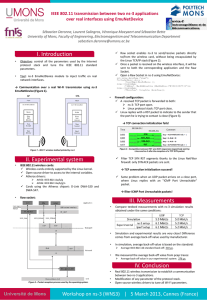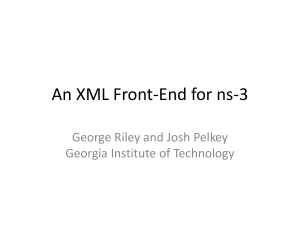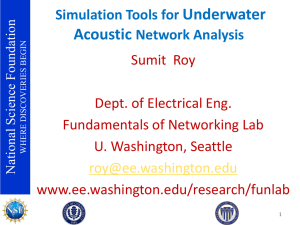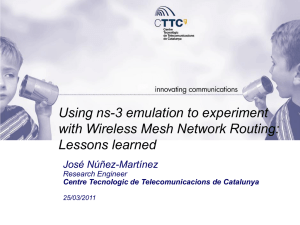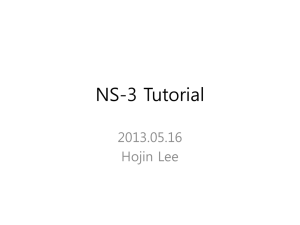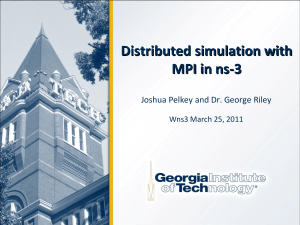Université de Mons - ns-3
advertisement
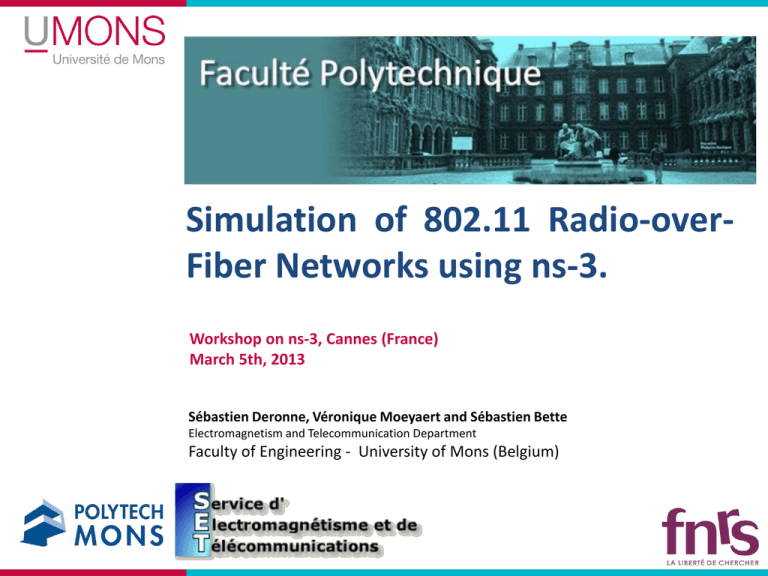
Simulation of 802.11 Radio-overFiber Networks using ns-3.
Workshop on ns-3, Cannes (France)
March 5th, 2013
Sébastien Deronne, Véronique Moeyaert and Sébastien Bette
Electromagnetism and Telecommunication Department
Faculty of Engineering - University of Mons (Belgium)
Talk outline
I.
Introduction: Radio-over-Fiber (RoF) networks
II.
Motivation
III. IEEE 802.11 RoF implementation in ns-3
IV. Model validation & exploitation
V.
Conclusions & future works
Université de Mons
Sébastien Deronne
|
Workshop on ns-3 (WNS3)
|
5 March 2013, Cannes (France)
2 / 25
Talk outline
I.
Introduction: Radio-over-Fiber (RoF) networks
II.
Motivation
III. IEEE 802.11 RoF implementation in ns-3
IV. Model validation & exploitation
V.
Conclusions & future works
Université de Mons
Sébastien Deronne
|
Workshop on ns-3 (WNS3)
|
5 March 2013, Cannes (France)
3 / 25
Radio-over-Fiber systems:
merge optical & wireless networks!
•
Current needs:
Higher data throughput
→ bring the fiber close to the users (FTTx).
Connection everywhere and at anytime
→ massive deployment of wireless systems.
•
Promising solution => Radio-over-Fiber systems combine:
Optical networks: capacity and transparency.
Wireless networks: flexibility and mobility.
Université de Mons
Sébastien Deronne
|
Workshop on ns-3 (WNS3)
|
5 March 2013, Cannes (France)
5 / 25
What is a radio-over-fiber system?
•
RF signal imposed on the optical carrier and transmitted through an optical
network.
•
Converted back to the electrical domain and transmitted over the radio channel to
the mobile stations.
Example: 802.11 RoF system
Université de Mons
Sébastien Deronne
|
Workshop on ns-3 (WNS3)
|
5 March 2013, Cannes (France)
5 / 25
The utilization of RoF extends radio coverage
while reducing RF propagation effects
• Advantages to use a RoF architecture:
Centralize whole processing functions at the central site: simplify
maintenance and reduce antennas complexity.
Reduce RF channel effects (↘ attenuation, ↘ fading, …);
No handover issues;
Same architecture to distribute several radio services (Wi-Fi, 4G,
WiMAX, ZigBee, …)
Université de Mons
Sébastien Deronne
|
Workshop on ns-3 (WNS3)
|
5 March 2013, Cannes (France)
6 / 25
The utilization of RoF increases radio coverage
while reducing power consumption
• Advantages to use a RoF architecture:
Increase coverage [1];
Reduce emitted power [1].
[1] Y. Josse, B. Fracasso, and P. Pajusco, Model for energy efficiency in radio over fiber distributed indoor antenna wi-fi network, on Proceedings of the 14th International
Symposium on Wireless Personal Multimedia Communications (WPMC), pages 131{135, 2011.
Université de Mons
Sébastien Deronne
|
Workshop on ns-3 (WNS3)
|
5 March 2013, Cannes (France)
7 / 25
Talk outline
I.
Introduction: Radio-over-Fiber (RoF) networks
II.
Motivation
III. IEEE 802.11 RoF implementation in ns-3
IV. Model validation & exploitation
V.
Conclusions & future works
Université de Mons
Sébastien Deronne
|
Workshop on ns-3 (WNS3)
|
5 March 2013, Cannes (France)
8/ 25
The performance analysis of Radio-over-Fiber
networks require a simulation model in ns-3
•
Transmission techniques to propagate a RF signal with good performance over
long optical fiber distances:
modulation format
chromatic dispersion effect
type of fiber
…
•
Investigation of the network performance in RoF systems:
capacity, latency, quality of service, …
impact of the physical layer on the MAC performance
protocol optimization regarding of the architecture
…
→ require a network simulator to quantify MAC performance !
BUT: no RoF modules developed for ns-3 …
→ implement RoF in ns-3 !!!
Université de Mons
Sébastien Deronne
|
Workshop on ns-3 (WNS3)
|
5 March 2013, Cannes (France)
9 / 25
Talk outline
I.
Introduction: Radio-over-Fiber (RoF) networks
II.
Motivation
III. IEEE 802.11 RoF implementation in ns-3
IV. Model validation & exploitation
V.
Conclusions & future works
Université de Mons
Sébastien Deronne
|
Workshop on ns-3 (WNS3)
|
5 March 2013, Cannes (France)
10 / 25
The Wi-Fi PHY layer needs to be changed in ns3 to support IEEE 802.11 RoF simulations
•
Optical links between the AP and wireless stations = propagation delay ↗
keep MAC layer
change PHY layer
•
Model assumptions:
Physical layer imperfections are not considered.
Optical channel = delay & loss computation.
Delay: time needed by the radio signal to travel along the fiber link.
Linear loss: attenuation introduced by the optical link (electrical loss = 2 x optical loss !).
Université de Mons
Sébastien Deronne
|
Workshop on ns-3 (WNS3)
|
5 March 2013, Cannes (France)
11 / 25
The Wi-Fi PHY layer needs to be changed in ns-3
to support IEEE 802.11 RoF simulations
•
•
Most of ns-3 Wi-Fi modules can still be used for IEEE 802.11 RoF simulations.
ns-3 Wi-Fi PHY layer needs to be changed!
Université de Mons
Sébastien Deronne
|
Workshop on ns-3 (WNS3)
|
5 March 2013, Cannes (France)
12 / 25
A new PHY module has been implemented to
relay packets from one channel to another.
•
OpticalChannel: compute delay and loss of optical
transmissions.
•
WirelessChannel: YansWifiChannel modified to fit
with our implementation.
•
ApWifiPhy:
Instance attached to the access point.
YansWifiPhy modified to handle with the
OpticalChannel module.
•
StaWifiPhy:
Instance attached to each station.
YansWifiPhy modified to handle with the
WirelessChannel module.
•
RofRelayWifiPhy:
Instance attached to each remote antenna.
New physical layer module which forwards
packets from one channel to another.
Université de Mons
Sébastien Deronne
|
Workshop on ns-3 (WNS3)
|
5 March 2013, Cannes (France)
13 / 25
A new device model has been implemented to
set the position of remote antenna units.
WifiNetDevice:
• Hold together all objects used by AP and stations.
• MAC & PHY layers + channel.
• Ability to set the position of AP and stations.
RofRelayDevice:
• Hold together all objects used by a remote antenna.
• PHY layer + channel.
• Ability to set the position of each distributed antenna in the network.
The position of each device is used by the Optical Channel and the Wireless
Channel: propagation delay and propagation loss depend on distance.
Université de Mons
Sébastien Deronne
|
Workshop on ns-3 (WNS3)
|
5 March 2013, Cannes (France)
15 / 25
Optical channel module computations
Optical delay computation (τ):
where L = optical distance
ν = light speed in fiber
𝑐0 = light velocity in the vacuum
n = fiber refractive index
By default: n = 1.5
5 µs per kilometer of fiber
Optical loss computation:
Optical Loss = L x 0.2 dB/km
Electrical loss = 2 x L x 0.2 dB/km
Université de Mons
Sébastien Deronne
|
Workshop on ns-3 (WNS3)
|
5 March 2013, Cannes (France)
16 / 25
Optical channel module behaves differently for
upstream and downstream signals.
• Signal sent by the AP: sent to all RAUs attached to the OpticalChannel
module.
• Signal sent by a RAU: only transmitted to the AP and is not received by
other RAUs.
Université de Mons
Sébastien Deronne
|
Workshop on ns-3 (WNS3)
|
5 March 2013, Cannes (France)
16 / 25
Talk outline
I.
Introduction: Radio-over-Fiber (RoF) networks
II.
Motivation
III. IEEE 802.11 RoF implementation in ns-3
IV. Model validation & exploitation
V.
Conclusions & future works
Université de Mons
Sébastien Deronne
|
Workshop on ns-3 (WNS3)
|
5 March 2013, Cannes (France)
17 / 25
Model validation is done using a simple Radioover-Fiber configuration
Model validation:
• Comparison with published Opnet results.
•
Theoretical prediction:
Throughput(F) =
𝑃𝑎𝑦𝑙𝑜𝑎𝑑
𝑇𝐹=0 +2 ∗𝐹
where: F = fiber length
𝑇𝐹=0 = transmission time when F = 0
802.11b over RoF
Université de Mons
Sébastien Deronne
802.11g over RoF
|
Workshop on ns-3 (WNS3)
|
5 March 2013, Cannes (France)
18 / 25
We used our model for the simulation of RoF
distributed antenna systems.
Interest: study performance of RoF distributed
antenna systems.
Considered scenario:
• 4 RAUs & 4 stations where groups of
station(s) are hidden from each other.
• Each station receives only once all frames
transmitted by the AP and do not hear the
traffic sent by other stations.
• Basic access versus RTS/CTS access.
Results:
RTS/CTS access performs better than basic access
(also confirmed in A. Das et al. , “Effects on IEEE
802.11 MAC Throughput in Wireless LAN over
Fiber Systems”, in Journal of Lightwave
Technology, Vol. 25, No. 11, November 2007.).
Université de Mons
Sébastien Deronne
|
Workshop on ns-3 (WNS3)
|
5 March 2013, Cannes (France)
19 / 25
Talk outline
I.
Introduction: Radio-over-Fiber (RoF) networks
II.
Motivation
III. IEEE 802.11 RoF implementation in ns-3
IV. Model validation & exploitation
V.
Conclusions & future works
Université de Mons
Sébastien Deronne
|
Workshop on ns-3 (WNS3)
|
5 March 2013, Cannes (France)
20 / 25
Conclusions
•
Tool to support the simulation of IEEE 802.11 radio-over-fiber networks in ns-3.
•
Validated through comparisons with theoretical predictions and with Opnet
simulation results.
•
Model supports the simulation of Distributed Antenna Systems.
•
Wiki page: https://www.nsnam.org/wiki/index.php/NS-3_optical_network_models
•
Code soon online!
Université de Mons
Sébastien Deronne
|
Workshop on ns-3 (WNS3)
|
5 March 2013, Cannes (France)
21 / 25
Future work 1: Wi-Fi receiver model to handle
with simulcast conditions
• Scenario: coverage of the remote antennas overlap with each others.
• When a packet is transmitted by a station: the AP receives several times
the same signal quite close in time and in power (simulcast)
• ns-3 Wi-Fi model doesn’t handle with simulcast…
→ Change existing Wi-Fi receiver model to handle with simulcast
conditions !
Université de Mons
Sébastien Deronne
|
Workshop on ns-3 (WNS3)
|
5 March 2013, Cannes (France)
22 / 25
Future work 2: provide a more accurate optical
channel model
• Our OpticalChannel module: compute delay & loss.
• Doesn’t support other optical properties (dispersion effect,
nonlinearities…)
• Optical network components are currently being developed for ns-3.
→ integrate those modules to provide a more accurate optical channel
model!
Université de Mons
Sébastien Deronne
|
Workshop on ns-3 (WNS3)
|
5 March 2013, Cannes (France)
23 / 25
Future work 3: a protocolindependent Radio-over-Fiber model
• Radio-over-Fiber model supports Wi-Fi radio signals.
• Same model could be used for different wireless protocols (Wi-Fi, ZigBee,
WiMAX, ...).
→ develop a protocol-independent Radio-over-Fiber model !
Université de Mons
Sébastien Deronne
|
Workshop on ns-3 (WNS3)
|
5 March 2013, Cannes (France)
24 / 25
Thank you !
Université de Mons
Sébastien Deronne
|
Workshop on ns-3 (WNS3)
|
5 March 2013, Cannes (France)
25 / 25
